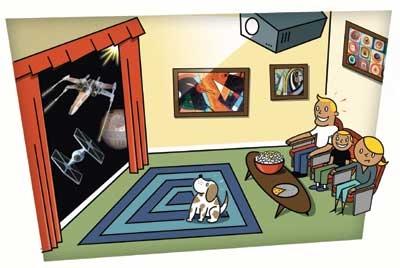Get the BIG Picture

If you're shopping for an HDTV, you've probably noticed that the news stories and Sunday circulars all seem to focus either on expensive flat-panel plasma and LCD sets or on more affordable LCD or DLP rear-projection TVs. It's no wonder, since these sets combine cutting-edge technology and standard one-box versatility in a package that looks way sexier than tried-and-true tube-based TVs.
But before you settle on one of these HDTV options, I'd like to propose an alternative that you - and the sales kid at Best Buy - might not have considered: a front projector. They're not for everyone, but the reasons for not getting a projector are fading fast as the models get smaller, the prices go lower, and they get easier to set up and maintain. If the ten reasons below suggest that a projector is a good fit for your lifestyle, you might be ripe to convert.
1. Super-sized picture Here's the single best reason to get a projector: even a typical budget-priced ($1,000 to $3,000) home theater model can easily deliver an image from 70 to 120 inches or more (measured diagonally). As anyone who's graduated from a 27-inch to a 36-inch TV can tell you, the more picture, the better. This is particularly true with HDTV, which delivers movie theaterlike impact with a high-resolution projector. Go ahead and try to find an affordable 70-inch HDTV, let alone one that fits in your living room. (Al Griffin looks at three budget-price projectors in Big-Screen Megabargains and checks out four higher-end models in Super-Size HDTV.)
2. Look, ma - no gearCompared with a traditional tube TV or a rear-projection set, a front projector takes up almost no space. Permanently mount it on the ceiling or temporarily set it on a coffee table, and it's effectively out of the way. Likewise, you can make the projection screen disappear when you're not using it by having it retract into the wall or ceiling. Or you can make your house look like a real movie theater and hide a standard framed and wall-mounted screen behind curtains, to be revealed only when it's time to watch a flick. Even if you decide to keep the screen in plain sight, it's still a lot less objectionable to look at, and takes up a lot less space, than a bulky big-screen TV.
3. A screen is optionalProjecting the image onto a white wall can give you an acceptable picture as long as the wall is actually white - flat latex paint is best - and relatively smooth. Adding a black frame around this area, even if you just paint it on, also helps increase apparent contrast. Companies like Goo Systems (goosystems.com) and JDL Industries (305-599-2022) even sell paint-on screen substitutes. But, unless you absolutely can't afford one, a screen is always the best way to go. A regular white wall robs the image of brightness, contrast, and color saturation, and it can also affect resolution, depending on the texture of the wall. HDTV-worthy screens cost less than you think - Da-Lite (da-lite.com), for instance, sells its pull-down 92-inch High Contrast Matte White Model B for $256 - and you can bring your picture close to perfection with higher-end ($500 to $5,000) models from companies like Da-Lite, Stewart (stewartfilm.com), and Draper (www.draperinc.com).
- Log in or register to post comments



































































